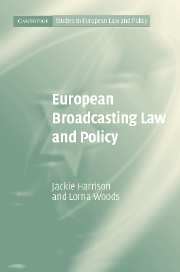Book contents
- Frontmatter
- Contents
- Series Editors' Preface
- Preface
- Case list
- PART I
- PART II
- 6 Access
- 7 Media ownership: impact on access and content
- 8 Jurisdiction, forum shopping and the ‘race to the bottom’
- 9 Advertising placement and frequency: balancing the needs of viewers and commercial interests
- 10 Negative content regulation
- 11 Positive content regulation: quotas
- 12 Privatisation of sport and listed events
- 13 State aid: constraints on public service broadcasting
- PART III
- Appendix
- Bibliography
- Index
12 - Privatisation of sport and listed events
Published online by Cambridge University Press: 29 July 2009
- Frontmatter
- Contents
- Series Editors' Preface
- Preface
- Case list
- PART I
- PART II
- 6 Access
- 7 Media ownership: impact on access and content
- 8 Jurisdiction, forum shopping and the ‘race to the bottom’
- 9 Advertising placement and frequency: balancing the needs of viewers and commercial interests
- 10 Negative content regulation
- 11 Positive content regulation: quotas
- 12 Privatisation of sport and listed events
- 13 State aid: constraints on public service broadcasting
- PART III
- Appendix
- Bibliography
- Index
Summary
Introduction
We have seen in chapter 2 that broadcasting is perceived as fulfilling certain social and cultural functions. To enable it to do so, certain types of content must be available to all viewers. Desirable content here includes news and current affairs programmes, wider factual and learning programming, and certain other events which are also perceived to facilitate social and cultural identity formation, particularly sport. Typically, sport has been available free to air on mass-audience channels. Passive viewers could access, and take for granted, certain mainstream sporting events. Yet sport is a valuable commodity, something that consumer viewers were, and are, willing to pay for. Premium content such as sporting rights was, and still is, central to the ability of broadcasters (and providers of new media services) to enter the market and remain there. This strategy has been facilitated by technological change, particularly through subscriber management systems and encryption technologies which enable the exclusion of those not willing or able to pay. Certain types of content have become commodified and privatised rather than generally available. The phrase ‘content is king’ is true for pay TV, whose model of the viewer is a consumer who is willing and able to pay. Serving the citizen viewers' interests is not the concern of the private sports broadcasters.
This chapter explores how different value systems interrelate in European broadcasting policy and the consequences this has for the access rights of different viewers, as well as different broadcasters, to sporting events.
- Type
- Chapter
- Information
- European Broadcasting Law and Policy , pp. 266 - 289Publisher: Cambridge University PressPrint publication year: 2007



